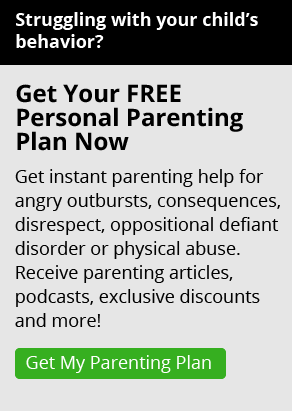Most parents would love to see their kids manage their intense emotions without falling apart or taking their frustrations out on others. It’s hard to watch your children react to their upset feelings by flying off the handle, holding a grudge, complaining or insulting the people around them when their emotions are running high. As parents, there are times when we simply don’t know what to do.
Let’s face it, it can be hard for all of us to manage our emotions. We all lose it from time to time or let our feelings get the better of us. And few children manage their difficult emotions—emotions like disappointment, fear, anger, hurt or frustration—very well. The difference between adults and kids is that we’ve learned how to cope with these feelings appropriately, and kids haven’t gotten the hang of it yet.
What This Looks Like
What does that look like? They have temper tantrums, cry, pout, lash out at other people, panic, break things, take their anger out on others, ignore you, refuse to participate, whine, complain, hold a grudge, and spew out negativity. Kids don’t just act out—they also “act in” as James Lehman said, by giving you the silent treatment and shutting down passive aggressively. I call this “spilling black ink” around the house.
Why is it so hard for kids to learn how to manage their emotions? It’s easier for all of us to have others feel responsible and pick up the pieces. If you don’t have to deal with your emotions, it’s much easier not to do it—particularly if someone else will do it for us. And sadly, sometimes kids come to believe they really can’t handle their emotions on their own, and need others to help them work through everything.
It’s natural for your kids’ strong reactions to trigger your own feelings of fear, anger, and uncertainty—causing you to get upset, too. Their eruptions can dumbfound us and leave us unsure how to be helpful. And of course, from years of trying to calm them down when they were very young, we rush in out of habit. (And along the way, you have probably learned that your attempts to help or soothe, even with our best intentions, can backfire and upset them even more.)
What’s Your Child’s Trigger?
Each of us has our very own particularly sensitive areas—for some it’s around disrespect, for others it might be around approval, injustice, autonomy, or pride. These sensitive spots are what we often refer to as our “triggers,” because when one is pulled, it causes a strong reaction in us; when someone pushes one of our buttons—even unintentionally—we usually get angry or upset with that person.
I know a teen named Eli* who loses it every time a parent, teacher or friend tells him what to do. Eli has a strong and reactive sensitivity about his independence. This makes it one of his buttons, and it’s also something that causes him to get angry and fight with others.
What Eli doesn’t realize is that if he didn’t have that button, it couldn’t get pushed at all. If he weren’t so overly triggered by the issue of “independence,” for example, and sensitivity about being told what to do, he wouldn’t be upset so often.
Being unaware of this trigger leaves him vulnerable and gives others the power to make him distressed or angry. What he doesn’t understand is that being told what to do is a sensitivity of his and that he is reacting to something within himself. He continues blaming others and trying to get them to stop, rather than taking responsibility for his own trigger.
Eli is not alone. Most of us have many triggers we are unaware of. We spend our energy angry with people who intentionally or unintentionally push our buttons without recognizing that we have handed them something to push.
Here are some other examples. 13-year-old Sidney would blow a fuse when she thought her friends or sisters were “acting like they were better than she was.” Her sensitivities were often around her sense of pride. 10-year-old Jake gets upset if he feels criticized by anyone—his parents say it’s like walking on eggshells to be with him. His sensitivities were around issues of approval.
What to do?
Parents can be helpful to their kids by first helping them gain self awareness. You might say to your child, “I notice you often get triggered when you think something isn’t fair – are you aware of that?” Or, “I see you often get angry when someone argues with you, as if you feel like you aren’t being respected. That seems like a real button for you.” Of course, giving kids feedback can be one of their triggers if they’re particularly sensitive about how you perceive them, so know that going in. (If this is the case, you might ask your spouse or another trusted adult to have this conversation with them.)
Also, know that you will be more helpful to your children if you work on gaining your own self awareness. Pay close attention to your buttons and work to de-activate them. This will help you to manage your own emotions and help you to be less reactive to your kid’s sensitivities – which can be one in the same. (The benefit? When you do this, everyone will become calmer as a result.)
Deactivating the Buttons
How do sensitivities get rooted? In other words, how do those buttons get created in the first place? Where do they come from and how can we learn to respond to them better and help our children do the same?
Triggers are based on how we are wired, and are also often programmed in early childhood by the ways our parents and families behaved and responded to us. Although the circumstances may have changed and are no longer meaningful, we might still respond as if they are relevant to us now, so seemingly inconsequential things can “set us off.” The same is true for your child.
1. Ask yourself these questions:
What are the typical circumstances that set your child off? What sets you off?
What are his or her buttons? What are yours? (Are they one and the same?)
Which categories would you put most of your buttons under? How about your child’s?
Here are some typical ones:
- Approval
- Pride
- Injustice
- Autonomy
- Respect
- Envy
- Shame
Once you’ve identified your child’s triggers, tell him what you see. You can then ask him, “How can you react differently next time? The next time you think something isn’t fair, how can you respond appropriately instead of punching the wall, yelling and cursing, or breaking something?” Have your child come up with some ways to respond. Consider actually asking him to write down a list of things he can do next time he’s triggered.
2. Believe that your child can take care of herself. It’s important for you to hold the belief that your child can take care of her emotions on her own. A lot of parents will jump in and try to “fix” things. Let’s face it, seeing your child upset can be very difficult, and can make us feel helpless and distressed. But if you step in and try to solve your child’s problems for her, know that inadvertently you’re keeping the situation going. If you over-empathize because you want to make your child feel better, it can put too much “weight” on the problem and magnify it. Your child then gets the message that it’s even worse than she thought—and only mom or dad can fix it for her.
Bottom line: Don’t get involved in your child’s emotions out of guilt or your own need to make her feel better. Instead, think, “She’s having an uncomfortable emotion that she needs to work through. I can stand next to her box but I don’t have to get into it.”
You don’t have to help your child through difficult emotions by processing everything with her. You can be empathetic without saying “Oh my poor baby!” If you react and give attention to every mood and feeling your child has, that’s what she will read and buy into. It’s better to say, “I know it’s hard and you’re disappointed and upset. Take some time to yourself. When you’re done you can come out and join us.”
3. Don’t minimize or make your child feel like his emotions are “wrong”. On the other end of the spectrum, some parents have a hard time dealing with their child’s emotions. In response, they might try to make their child feel like their emotions are wrong, saying things like, “Why are you crying about this? That’s silly!” or “You’re angry about that?” Give them the respect and space to deal with emotions on their own, even if it seems silly or like they are overreacting. (This doesn’t mean they get to behave badly or treat the rest of the family rudely. It just means they should be given time to process emotions on their own in their room, for example.)
4. Calm yourself first. Have you ever heard of the quote, “Put your own oxygen mask on first”? This applies to staying calm as well. If you can learn how to calm yourself down while your child is in distress and model an appropriate response, they will learn to work through it. You can be a sounding board, but if you get too distressed yourself, you’re not helping them learn to calm themselves down. Always pause before reacting. Be matter of fact and businesslike, let your child work through his upset and then guide him to what he needs to do. Listen, but don’t prolong the situation by indulging him.
5. Realize that triggers are handed down through generations. You can deactivate your buttons by recognizing that this strong sensitivity that you carry was really passed down to you through the generations and is not as personal as you thought it was. Often, something was your mother’s hot button because it was her mother’s hot button, and so on. As you detach from your triggers, they will become less of an issue for you and as a result, less of one for your children. You will all be able to put the issue of “sensitivity” to certain hot buttons into perspective, and your whole family will benefit.
*Names in this article have been changed.
Related Content:
Challenging Parenting Issues: 5 of the Hardest Things Parents Face
Misreading Social Cues and Your Child’s Behavior
About Debbie Pincus, MS LMHC
For more than 25 years, Debbie has offered compassionate and effective therapy and coaching, helping individuals, couples and parents to heal themselves and their relationships. Debbie is the creator of the Calm Parent AM & PM™ program and is also the author of numerous books for young people on interpersonal relations.
You must log in to leave a comment. Don't have an account? Create one for free!




dirkgentley77
You describe a common situation where you talk with your
daughter during a calm time about what she can do differently, and then when
she is upset she appears to forget about the conversation you had. For
most people, being able to connect to the rational, logical parts of the brain
when experiencing intense emotions is hard; for kids and teens who tend to have
a lower frustration tolerance, it can be even more difficult. Part of the
behavior change process is having regular ongoing conversations about how she
can handle situations differently and coming up with a simple, clear plan as
Sara Bean points out in her article http://www.empoweringparents.com/the-surprising-reason-for-bad-child-behavior.php.
Knowing your daughter’s triggers can also be useful so you can be proactive in
recognizing potential issues, and coaching her toward more appropriate behavior
before her buttons are pushed. You are not alone in dealing with this
issue. Please let us know if you have any additional questions; take
care.